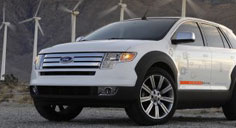Research into hydrogen is part of our overall effort to address the challenges of climate change and energy independence. We're moving ahead with a range of technology solutions simultaneously, including hybrid vehicles, hydrogen fuel cells, hydrogen internal combustion engines, ethanol, clean diesel and refinements to gasoline-fueled engines and advanced transmissions.
Some of the technology, such as that seen in Ford's lineup of hybrid vehicles, represents near-term approaches. Other technology, including hydrogen fuel cells, must be viewed as a long-term option.

World's First Fuel Cell Plug-in Hybrid
Ford Edge with HySeries Drivetm is the world's first drivable fuel cell hybrid electric plug-in that combines an onboard hydrogen fuel cell generator with lithium-ion batteries to deliver more than 41 mpg with zero emissions.
The plug-in hybrid is powered by a 336-volt lithium-ion battery pack at all times. The vehicle drives the first 25 miles each day on stored electricity alone, after which the fuel cell begins operating to keep the battery pack charged. This provides another 200 miles of range for a total of 225 miles with zero emissions.
An onboard charger (110/220 VAC) can refresh the battery pack when a standard home outlet is available, making the concept a true plug-in hybrid.
Innovative Drivetrain
The HySeries Drive name is derived from the powertrain's structure: a hydrogen fuel-cell-powered series hybrid drivetrain. This highly innovative approach reduces the size, weight, cost and complexity of a conventional fuel cell system by more than 50 percent. It also promises to more than double the lifetime of the fuel cell stack.
Impressive Fuel Economy
The HySeries Drive powertrain delivers a combined city/highway gasoline equivalent fuel economy rating of 41 mpg. For those who drive fewer than 50 miles each day, the average jumps to more than 80 mpg. Individual experiences will vary widely and can stretch out the time between fill-ups to more than 400 miles: drivers with modest daily needs would need to refuel only rarely, drivers who travel less than 50 miles each day will see fuel economy well over 80 mpg, while those with long daily commutes will see somewhat lower numbers as the fuel cell must run a larger fraction of the time.
Future Flexibility
The vehicle is built on a flexible powertrain architecture that will enable us to use new fuel and propulsion technologies as they develop without redesigning the vehicle.
Making Hydrogen Vehicles Viable
Certainly, many significant technical hurdles need to be overcome before a vehicle such as the Edge with HySeries Drive can become a reality. Fuel cell vehicles remain expensive, costing millions of dollars each. And the single biggest hurdle to plug-ins remains the cost of lithium-ion batteries. Much work also needs to be done to make fuel cells more durable and to create a hydrogen infrastructure.
On the Road
We currently have a fleet of 30 hydrogen-powered Focus fuel cell vehicles on the road as part of a worldwide, seven-city program to conduct real-world testing of fuel cell technology. The fleet has accumulated more than 300,000 miles since its inception.
As a hydrogen infrastructure is developed and implemented for the fleet at each location, lessons learned are being generated to ensure that the customer and hydrogen fueling interface is seamless and customer friendly.

